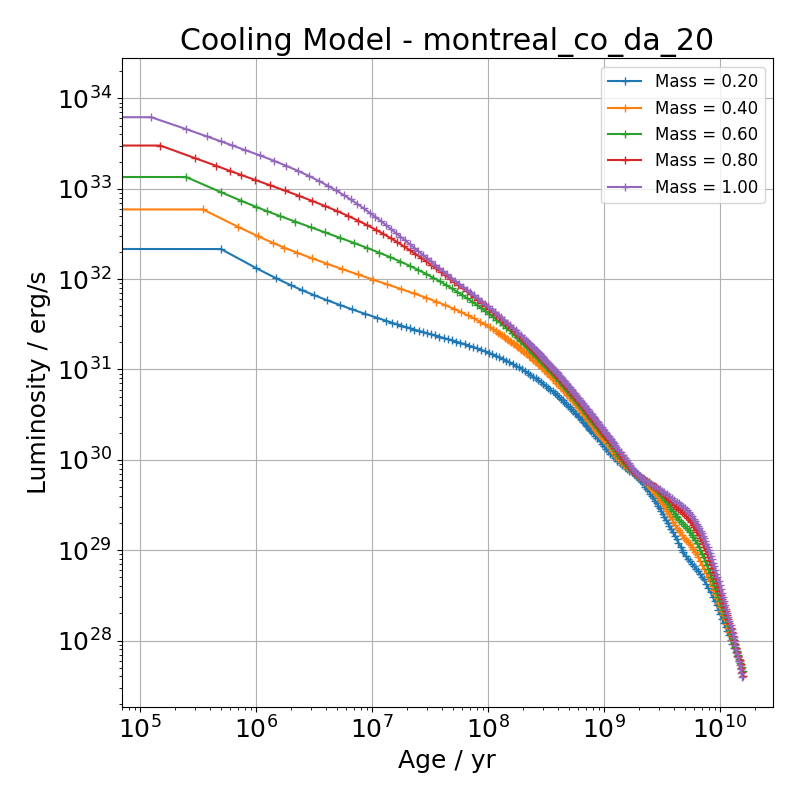White Dwarf Cooling¶
Most of the internal energy of a WD is the residual heat from the progenitor once it passed the planetary nebula phase. However, there are various physical processes that can provide an appreciable amount of energy and govern the cooling rate of a WD at different stages. Following the time sequence in which the physical processes that has direct effects to the photo-luminosity: (1) in the first \(10^{8}-10^{9}\) years, shell burning of hydrogen via pp-chain can contribute up to 30% of the total luminosity (Renedo et al. 2010). (2) Neutrino losses – contribute to a significant fraction of energy loss in the early time of WDs when they were still hot, in the case of massive WDs, neutrino bremsstrahlung effect must also be taken into account (Martin, Georg & Achim 1994, Itoh et al. 1996). (3) Gravitational settling of :math:`^{22}`Ne in intermediate to massive WDs releases sufficient gravitational potential energy to prolong the cooling times (`Deloye \& Bildsten 2002 <https://ui.adsabs.harvard.edu/abs/2002ApJ...580.1077D/abstract>`_, Althaus et al. 2010). The heavier :math:`^{22}`Ne relative to the environment that is dominated by carbon, oxygen and nitrogen leads to a slow settling towards the core. This effect is the most obvious in the old and metal-rich systems, such as NGC 6791 (`Bedin et al. 2008 <https://ui.adsabs.harvard.edu/abs/2008ApJ...678.1279B/abstract>`_, Garvia-Berro et al. 2010). (4) In the late time of the WD evolution, convection plays a significant role in slowing down the cooling. As temperature decreases, the convective zone grows deeper into the interior and eventually reaches the degenerate core (see Figure 11 from Althaus, Corsico, Isern, & García-Berro, 2010). This efficiently replenish the energy radiated away from the photosphere, thus this process known as the convective coupling, modifies the relations between the WD luminosity and core temperature (D’Antona & Mazzitelli 1989, Fontaine, Brassard & Bergeron 2001). (5) Crystallisation occurs as the non-degenerate ions evolve from gas to fluid and eventually solid. The liquid-solid transition releases latent heat that slows down the cooling process. This also couples with the release of gravitational energy associated with changes in the carbon-oxygen profile (Salaris et al. 1997) when the heavier oxygen-rich crystals displace carbon as a result of gravitational settling. Depending on the changes in the carbon-oxygen abundance profile, and the choice of phase diagram of a carbon-oxygen mixture, it modifies the rate of cooling and this specific effect is colloquially known as the (6) Phase Separation effect. (7) Coulomb Interactions modify the thermodynamical properties of the ionic gas, in particular the specific heat. Its strength is determined by the Coulomb coupling parameters. At first, the parameter is small, it slowly increases as an WD cools and the ions begin to change from gas to liquid and eventually form lattice. This releases latent heat that contribute to ~5% of the total luminosity (Shaviv & Kovetz 1976). At late time, few modes of the lattice are excited, the heat capacity drops according to the Debye law, this results in enhanced cooling. This process kicks in after \(10^9\) yr for a \(1.0\,\odot\) WD and over a Hubble time for a \(0.5\,\odot\) WD. See below the plot of the luminosity as a function of cooling age.
